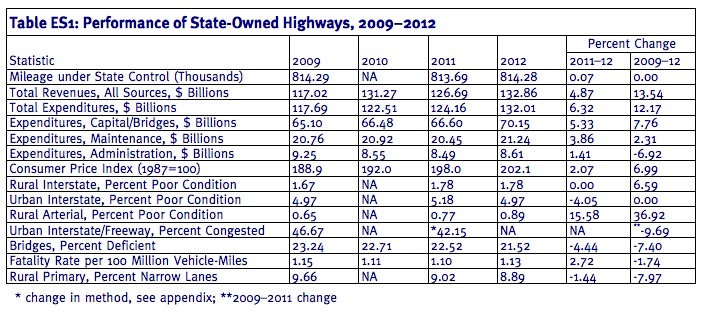REASON FOUNDATION
Executive Summary
Reason Foundation’s 21st Annual Highway Report tracks the performance of the 50 state-owned highway systems from 1984 to 2012. Each state’s overall rating consists of 11 category rankings. The rankings include highway expenditures, Interstate and rural primary road pavement conditions, bridge conditions, urban Interstate/freeway congestion, fatality rates and narrow rural arterial lanes. The study is based on spending and performance data submitted by the state highway agencies to the federal government. It also reviews changes in highway performance since 2009, the prior report’s focus.
Table ES1 summarizes recent system trends for key indicators. Although individual highway sections (roads, bridges, pavements) steadily deteriorate over time due to age, traffic and weather, they are periodically improved by maintenance and re-construction. Over the past four years the overall condition of the system has improved. In 2012 the overall condition of the U.S. state-owned highway system continued to improve, but progress appears to be slowing.
Overall, the system’s condition continued to improve from 2009 to 2012 (Figure ES1). Four of the seven key indicators of system condition showed improvement, including sizable decreases in urban Interstate congestion (which could be related to the change in method—see Appendix), fatality rates, deficient bridges and narrow rural lanes. But rural Interstate pavement condition and rural arterial pavement condition worsened, and urban Interstate pavement condition was unchanged. Between 2011 and 2012, two indicators worsened, one stayed the same, and three improved. These changes, following an increase in both absolute and per mile expenditures, suggest that an increase of focus on problems can yield positive results, but at a declining rate. Overall, expenditures for state-owned roads have increased about 12 percent since 2009, and 6.3 percent since 2011. Both increases exceed the rate of inflation. The 2009 recession year expenditure were slightly lower than 2008 expenditures (about 0.6 percent). In general, states have become more cost-efficient over the last four years: administrative costs have decreased almost seven percent, although there was a slight uptick from 2011 to 12. Additional funds were allocated to capital and bridge efforts (expenditures up 5.3 percent from 2011) and maintenance activities (expenditures up 3.9 percent from 2011).
The top rankings continue to be dominated by relatively small rural states. Wyoming led the cost-effectiveness ratings, followed by Nebraska, South Dakota, South Carolina and Kansas. But two large states, Texas and Missouri, were top-12 performers, with Georgia (13th) and Ohio (14th) close behind. At the bottom were Hawaii, Alaska, New Jersey, Rhode Island and Massachusetts. Most states continued to improve their systems. Increasingly, system performance problems seem to be concentrated in a few states:
- Almost half (49.7 percent) of the poor-condition rural Interstate mileage is in just five states: Alaska, California, Colorado, Washington and Indiana.
- Almost half (49.5 percent) of the poor-condition urban Interstate mileage is in just six states: California, New York, Louisiana, New Jersey, Michigan and Texas.
- Two states (Alaska and Hawaii) reported more than 10 percent of their rural principal arterial mileage to be in poor condition.
- Eight states (Florida, Hawaii, Maryland, Illinois, California, Nevada, Georgia and Indiana) reported more than half of their urban Interstates/freeways congested.
- Although bridge conditions are steadily improving, seven states (Rhode Island, New York, Pennsylvania, Massachusetts, Hawaii, Connecticut and West Virginia) reported that more than 1/3rd of their bridges are deficient, with Rhode Island reporting more than half of its bridges as deficient.
- Most states are improving their fatality rates. But eight states (West Virginia, South Carolina, Montana, North Dakota, Arkansas, Kentucky, Louisiana and Mississippi) reported a rate greater than 1.5 fatalities per 100 million vehicle-miles.
- Three states (Pennsylvania, West Virginia and Virginia) reported more than 1/3rd of their rural principal arterial mileage with narrow lanes.
Download full version (PDF): 21st Annual Report on the Performance of State Highway Systems
About Reason Foundation
reason.org
“Reason Foundation advances a free society by developing, applying, and promoting libertarian principles, including individual liberty, free markets, and the rule of law. Reason Foundation produces respected public policy research on a variety of issues and publishes the critically-acclaimed Reason magazine. Together, our top-tier think tank and political and cultural magazine reach a diverse, influential audience, advancing the values of choice, individual freedom and limited government.”
Tags: Reason Foundation








 RSS Feed
RSS Feed